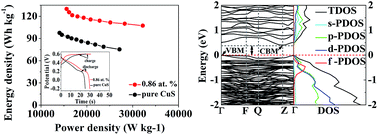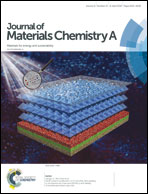Quantum capacitance of CuS:Ce3+ quantum dots as high-performing supercapacitor electrodes†
Abstract
CuS:Ce3+ QDs are successfully synthesized by the diffusion control and trapped dopant methods. The Dirac points of CuS have been opened owing to the presence of an S vacancy or Ce doping defects. The high specific capacitance of CuS:Ce3+ quantum dots (QDs) mainly arises from the impurity energy level introduced by the Ce atoms, which may store a large amount of energy. The excellent electrochemical properties of CuS:Ce3+ can be attributed to its quantum capacitance, unique band structures and great conductivity, which allows efficient charge transport and electrolyte diffusion. CuS:Ce3+ (0.86 at%) QDs for supercapacitors deliver not only a large specific capacitance of 2853 F g−1 even at 1.0 A g−1, but also fine rate properties with 2175 F g−1 at 10 A g−1 and excellent capacitance retention of nearly 95% over 10 000 circulations in 6 M KOH electrolyte. The supercapacitor, whose active electrodes are made of CuS:Ce3+ (0.86 at%) QDs, demonstrates remarkable energy density of 129.87 W h kg−1 at a power density of 15 584.4 W kg−1. It is noteworthy that even at a high power density of 32 196.1 W kg−1, the energy density can reach 107.32 W h kg−1. In addition, the specific capacitance of CuS:Ce3+ QDs presents a parabolic trend with increase of Ce doping concentration. A theoretical calculation is carried out in this paper to systematically explain the origin of the quantum capacitance of CuS and CuS:Ce3+ QDs.



 Please wait while we load your content...
Please wait while we load your content...